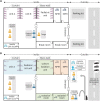Revised Triage and Surveillance Protocols for Temporary Emergency Department Closures in Tertiary Hospitals as a Response to COVID-19 Crisis in Daegu Metropolitan City
- PMID: 32419401
- PMCID: PMC7234857
- DOI: 10.3346/jkms.2020.35.e189
Revised Triage and Surveillance Protocols for Temporary Emergency Department Closures in Tertiary Hospitals as a Response to COVID-19 Crisis in Daegu Metropolitan City
Abstract
Background: When an emergency-care patient is diagnosed with an emerging infectious disease, hospitals in Korea may temporarily close their emergency departments (EDs) to prevent nosocomial transmission. Since February 2020, multiple, consecutive ED closures have occurred due to the coronavirus disease 2019 (COVID-19) crisis in Daegu. However, sudden ED closures are in contravention of laws for the provision of emergency medical care that enable the public to avail prompt, appropriate, and 24-hour emergency medical care. Therefore, this study ascertained the vulnerability of the ED at tertiary hospitals in Daegu with regard to the current standards. A revised triage and surveillance protocol has been proposed to tackle the current crisis.
Methods: This study was retrospectively conducted at 6 level 1 or 2 EDs in a metropolitan city where ED closure due to COVID-19 occurred from February 18 to March 26, 2020. The present status of ED closure and patient characteristics and findings from chest radiography and laboratory investigations were assessed. Based on the experience from repeated ED closures and the modified systems that are currently used in EDs, revised triage and surveillance protocols have been developed and proposed.
Results: During the study period, 6 level 1 or 2 emergency rooms included in the study were shut down 27 times for 769 hours. Thirty-one confirmed COVID-19 cases, of whom 7 died, were associated with the incidence of ED closure. Typical patient presentation with respiratory symptoms of COVID-19 was seen in less than 50% of patients, whereas abnormal findings on chest imaging investigations were detected in 93.5% of the study population. The chest radiography facility, resuscitation rooms, and triage area were moved to locations outside the ED, and a new surveillance protocol was applied to determine the factors warranting quarantine, including symptoms, chest radiographic findings, and exposure to a source of infection. The incidence of ED closures decreased after the implementation of the revised triage and surveillance protocols.
Conclusion: Triage screening by emergency physicians and surveillance protocols with an externally located chest imaging facility were effective in the early isolation of COVID-19 patients. In future outbreaks of emerging infectious diseases, efforts should be focused toward the provision of continued ED treatment with the implementation of revised triage and surveillance protocols.
Keywords: COVID-19 Crisis; Chest X-ray; Nosocomial Transmission; Revised Triage; Surveillance Protocol; Temporary ED Closure.
© 2020 The Korean Academy of Medical Sciences.
Conflict of interest statement
The authors have no potential conflicts of interest to disclose.
Figures



References
-
- National Law Information Center. Emergency medical service act. [Updated 2020]. [Accessed April 1, 2020]. http://www.law.go.kr/lsInfoP.do?lsiSeq=215835&efYd=20200324#0000.
MeSH terms
Grants and funding
LinkOut - more resources
Full Text Sources

